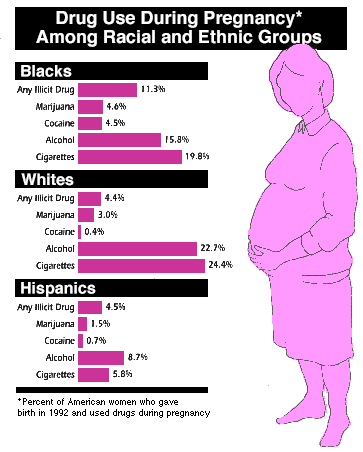More than 5 percent of the 4 million women who gave birth in the United States in 1992 used illegal drugs while they were pregnant, according to the first nationally representative survey of drug use among pregnant women. The NIDA-sponsored survey, which was released last fall, provides the best estimates to date of the number of women who use drugs during pregnancy, their demographic characteristics, and their patterns of drug use.
"Information from NIDA's National Pregnancy and Health Survey can help to guide public health policymakers who have to make decisions about prevention and treatment programs aimed at reducing the problem of drug abuse during pregnancy," said NIDA Director Dr. Alan I. Leshner. Dr. Leshner reported the survey's findings at a press briefing held during NIDA's conference on Drug Addiction Research and the Health of Women last September.
The survey gathered self-report data from a national sample of 2,613 women who delivered babies in 52 urban and rural hospitals during 1992. Based on these data, an estimated 221,000 women who gave birth in 1992 used illicit drugs while they were pregnant. Marijuana and cocaine were the most frequently used illicit drugs--2.9 percent, or 119,000 women, used marijuana and another 1.1 percent, or 45,000 women, used cocaine at some time during their pregnancy.
The survey found a high incidence of cigarette and alcohol use among pregnant women. At some point during their pregnancy, 20.4 percent, or 820,000, pregnant women smoked cigarettes and 18.8 percent, or 757,000, drank alcohol.
"We know for certain that these [legal] substances affect the health of the fetus and a woman during and after pregnancy," said Dr. Loretta D. Finnegan, NIDA's former senior advisor on women's issues. Health care practitioners should ask women about their use of cigarettes and alcohol during prenatal checkups and educate them about the health risks of licit drugs, said Dr. Finnegan, who now directs the Women's Health Initiative at the National Institutes of Health.
The survey also uncovered a strong link between cigarette smoking and alcohol use and the use of illicit drugs in this population. Among those women who used both cigarettes and alcohol, 20.4 percent also used marijuana and 9.5 percent took cocaine. Conversely, of those women who said they had not used cigarettes or alcohol, only 0.2 percent smoked marijuana and 0.1 percent used cocaine. "This finding reinforces the need for health practitioners to monitor the status of both licit and illicit drug use during pregnancy," said Dr. Leshner.

Besides providing the first national estimates of drug use during pregnancy, the survey also examined differences in the amount and types of drugs used by several racial and ethnic groups of women. Overall, 11.3 percent of African-American women, 4.4 percent of white women, and 4.5 percent of Hispanic women used illicit drugs while pregnant. While African Americans had higher rates of drug use, in terms of actual numbers of users, most women who took drugs while they were pregnant were white. The survey found that an estimated 113,000 white women, 75,000 African-American women, and 28,000 Hispanic women used illicit drugs during pregnancy.
The survey also described different patterns of licit and illicit drug use among white women and ethnic minorities. African-American women had the highest rates of cocaine use, mainly "crack," during pregnancy. About 4.5 percent of African-American women used cocaine compared with 0.4 percent of white women and 0.7 percent of Hispanic women who did so.
White women had the highest rates of alcohol and cigarette use. Nearly 23 percent of white women drank alcohol and 24.4 percent smoked cigarettes. By comparison, 15.8 percent of African-American women and 8.7 percent of Hispanic women drank alcohol and 19.8 percent of African-American women and 5.8 percent of Hispanic women smoked cigarettes. "These findings point to the importance of attending to cultural issues in drug abuse prevention and treatment efforts," said Dr. Finnegan.
Although women who used drugs during pregnancy generally decreased their rates of drug use throughout their pregnancy, they did not discontinue drug use, Dr. Leshner noted. "This finding indicates how gripping an illness drug addiction can be, even in the face of what may seem to be the ultimate incentive to stay drug free," Dr. Leshner said. Nevertheless, "it is a disease that can be treated and managed with appropriate interventions," he stressed.
"With the information the survey provides about the patterns of drug use by women during pregnancy, we will be better able to identify priorities we must address," said Dr. Finnegan. This will enable researchers to develop and test more effective approaches to the differential drug abuse treatment and prevention needs of women of childbearing age, she concluded.
